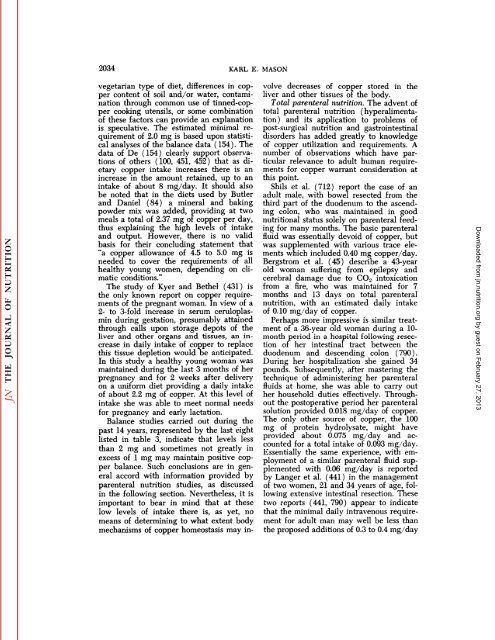conspectus of researchon copper metabolism and requirements
conspectus of researchon copper metabolism and requirements
conspectus of researchon copper metabolism and requirements
You also want an ePaper? Increase the reach of your titles
YUMPU automatically turns print PDFs into web optimized ePapers that Google loves.
2034 KARL E. MASON<br />
vegetarian type <strong>of</strong> diet, differences in cop<br />
per content <strong>of</strong> soil <strong>and</strong>/or water, contami<br />
nation through common use <strong>of</strong> tinned-cop<br />
per cooking utensils, or some combination<br />
<strong>of</strong> these factors can provide an explanation<br />
is speculative. The estimated minimal re<br />
quirement <strong>of</strong> 2.0 mg is based upon statisti<br />
cal analyses <strong>of</strong> the balance data ( 154). The<br />
data <strong>of</strong> De ( 154) clearly support observa<br />
tions <strong>of</strong> others (100, 451, 452) that as di<br />
etary <strong>copper</strong> intake increases there is an<br />
increase in the amount retained, up to an<br />
intake <strong>of</strong> about 8 mg/day. It should also<br />
be noted that in the diets used by Butler<br />
<strong>and</strong> Daniel (84) a mineral <strong>and</strong> baking<br />
powder mix was added, providing at two<br />
meals a total <strong>of</strong> 2.37 mg <strong>of</strong> <strong>copper</strong> per day,<br />
thus explaining the high levels <strong>of</strong> intake<br />
<strong>and</strong> output. However, there is no valid<br />
basis for their concluding statement that<br />
"a <strong>copper</strong> allowance <strong>of</strong> 4.5 to 5.0 mg is<br />
needed to cover the <strong>requirements</strong> <strong>of</strong> all<br />
healthy young women, depending on cli<br />
matic conditions."<br />
The study <strong>of</strong> Kyer <strong>and</strong> Bethel (431) is<br />
the only known report on <strong>copper</strong> require<br />
ments <strong>of</strong> the pregnant woman. In view <strong>of</strong> a<br />
2- to 3-fold increase in serum ceruloplasmin<br />
during gestation, presumably attained<br />
through calls upon storage depots <strong>of</strong> the<br />
liver <strong>and</strong> other organs <strong>and</strong> tissues, an in<br />
crease in daily intake <strong>of</strong> <strong>copper</strong> to replace<br />
this tissue depletion would be anticipated.<br />
In this study a healthy young woman was<br />
maintained during the last 3 months <strong>of</strong> her<br />
pregnancy <strong>and</strong> for 2 weeks after delivery<br />
on a uniform diet providing a daily intake<br />
<strong>of</strong> about 2.2 mg <strong>of</strong> <strong>copper</strong>. At this level <strong>of</strong><br />
intake she was able to meet normal needs<br />
for pregnancy <strong>and</strong> early lactation.<br />
Balance studies carried out during the<br />
past 14 years, represented by the last eight<br />
listed in table 3, indicate that levels less<br />
than 2 mg <strong>and</strong> sometimes not greatly in<br />
excess <strong>of</strong> 1 mg may maintain positive cop<br />
per balance. Such conclusions are in gen<br />
eral accord with information provided by<br />
parenteral nutrition studies, as discussed<br />
in the following section. Nevertheless, it is<br />
important to bear in mind that at these<br />
low levels <strong>of</strong> intake there is, as yet, no<br />
means <strong>of</strong> determining to what extent body<br />
mechanisms <strong>of</strong> <strong>copper</strong> homeostasis may in<br />
volve decreases <strong>of</strong> <strong>copper</strong> stored in the<br />
liver <strong>and</strong> other tissues <strong>of</strong> the body.<br />
Total parenteral nutrition. The advent <strong>of</strong><br />
total parenteral nutrition (hyperalimentation)<br />
<strong>and</strong> its application to problems <strong>of</strong><br />
post-surgical nutrition <strong>and</strong> gastrointestinal<br />
disorders has added greatly to knowledge<br />
<strong>of</strong> <strong>copper</strong> utilization <strong>and</strong> <strong>requirements</strong>. A<br />
number <strong>of</strong> observations which have par<br />
ticular relevance to adult human require<br />
ments for <strong>copper</strong> warrant consideration at<br />
this point.<br />
Shils et al. (712) report the case <strong>of</strong> an<br />
adult male, with bowel resected from the<br />
third part <strong>of</strong> the duodenum to the ascend<br />
ing colon, who was maintained in good<br />
nutritional status solely on parenteral feed<br />
ing for many months. The basic parenteral<br />
fluid was essentially devoid <strong>of</strong> <strong>copper</strong>, but<br />
was supplemented with various trace ele<br />
ments which included 0.40 mg <strong>copper</strong>/day.<br />
Bergstrom et al. (45) describe a 43-year<br />
old woman suffering from epilepsy <strong>and</strong><br />
cerebral damage due to CO^. intoxication<br />
from a fire, who was maintained for 7<br />
months <strong>and</strong> 13 days on total parenteral<br />
nutrition, with an estimated daily intake<br />
<strong>of</strong> 0.10 mg/day <strong>of</strong> <strong>copper</strong>.<br />
Perhaps more impressive is similar treat<br />
ment <strong>of</strong> a 36-year old woman during a 10month<br />
period in a hospital following resec<br />
tion <strong>of</strong> her intestinal tract between the<br />
duodenum <strong>and</strong> descending colon (790).<br />
During her hospitalization she gained 34<br />
pounds. Subsequently, after mastering the<br />
technique <strong>of</strong> administering her parenteral<br />
fluids at home, she was able to carry out<br />
her household duties effectively. Through<br />
out the postoperative period her parenteral<br />
solution provided 0.018 mg/day <strong>of</strong> <strong>copper</strong>.<br />
The only other source <strong>of</strong> <strong>copper</strong>, the 100<br />
mg <strong>of</strong> protein hydrolysate, might have<br />
provided about 0.075 mg/day <strong>and</strong> ac<br />
counted for a total intake <strong>of</strong> 0.093 mg/day.<br />
Essentially the same experience, with em<br />
ployment <strong>of</strong> a similar parenteral fluid sup<br />
plemented with 0.06 mg/day is reported<br />
by Langer et al. (441) in the management<br />
<strong>of</strong> two women, 21 <strong>and</strong> 34 years <strong>of</strong> age, fol<br />
lowing extensive intestinal resection. These<br />
two reports (441, 790) appear to indicate<br />
that the minimal daily intravenous require<br />
ment for adult man may well be less than<br />
the proposed additions <strong>of</strong> 0.3 to 0.4 mg/day<br />
Downloaded from<br />
jn.nutrition.org<br />
by guest on February 27, 2013
















